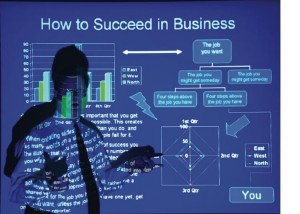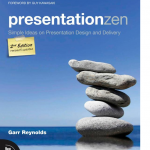 PowerPoint has been responsible for millions of dreadful presentations. Everyone reading this post has probably suffered through dozens of awful PowerPoints (and some unwittingly have given some!).
PowerPoint has been responsible for millions of dreadful presentations. Everyone reading this post has probably suffered through dozens of awful PowerPoints (and some unwittingly have given some!).
Fortunately, there is one thing you can do that will produce dramatic results.
A presentation has three parts – Preparation, Design, and Delivery. Unfortunately, PowerPoint guides people to combine Preparation and Design, leading to a highly unnatural delivery style.
If someone can read your PowerPoint and get up-to-speed without hearing you present, then why in the world are you wasting their time by talking?
To avoid this trap, approach your presentation like it is a speech. Design your presentation so that you can convey the information verbally without using any visual aids. When you are alone – driving to work or walking the dog – practice what you want to say. When I walk my dog I wear a Bluetooth earpiece so the neighbors don’t think I am crazy and talking to myself (but I think they are on to me!). When I have an especially good turn of phrase, I will record it as a Voice Memo on my iPhone so I don’t forget it.
In time the presentation will start to take shape. As you speak it back to yourself, you may think, “For this point, it may be especially impactful to show a picture of a house foundation.” This is where PowerPoint comes in. PowerPoint plays the role of your “pips” – it supports your presentation but do not drive it. The best presentations should move people even with a broken projector.
Not every point needs a slide, sometime images are better (but not always), and no slide should have more than eight words. If you feel like there is detailed information that the audience would find helpful – be it charts, graphs, or bulleted items, you can always hand out an information sheet with the information.
If someone can read your PowerPoint and get up-to-speed without hearing you present, then why in the world are you wasting their time by talking? If the goal is to just convey facts – you can do this without reading bullet points that the audience can clearly read too.
Presentations exist to inspire, to challenge, to convince. They exist to communicate ideas that go beyond mere facts. They involve storytelling and often intimacy or vulnerability. They are true to the presenter, genuine, and personal. None of these can be communicated well with bullets and pie charts. So next time you have a presentation, make PowerPoint the very last thing you use and you will deliver something far more impactful and memorable.
 Many of my presenting skills and ideas in this post came from a book called Presentation Zen: Simple Ideas on Presentation Design and Delivery (2nd Edition) (Voices That Matter)
Many of my presenting skills and ideas in this post came from a book called Presentation Zen: Simple Ideas on Presentation Design and Delivery (2nd Edition) (Voices That Matter)